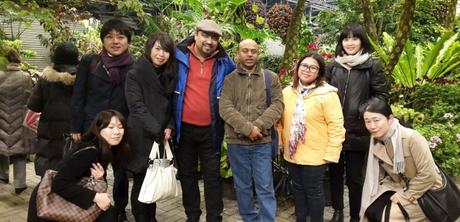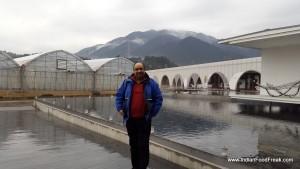
 If I were to tell you that Japan is a country full of sky scrapers or is technologically very advanced, you would say that this is common knowledge and perhaps, this will be the only line you will read in this post before moving to other interesting articles on the website. However, this post is much more than the obvious and goes beyond the heated seats in the washroom or how advanced their toilets are.
If I were to tell you that Japan is a country full of sky scrapers or is technologically very advanced, you would say that this is common knowledge and perhaps, this will be the only line you will read in this post before moving to other interesting articles on the website. However, this post is much more than the obvious and goes beyond the heated seats in the washroom or how advanced their toilets are.
Japan is one country which has never been in my travel wish list even though it is so much closer to India than US or Australia. It is a developed country, I love sushi, it has Disneyland for my kids, it has some of the best meats and seafood to satisfy the foodie in me, some interesting tourist spots but I wonder why Japan has not caught the fancy of travel freaks from our country. The only reasons I could come up with are that it has not been promoted very well plus the language barrier might have been the root cause.
It was due to an invitation from METI ( Ministry of Economy, Trade and Industry, Japan), coordinated by Accenture as their consulting partner, that I am off on my maiden visit to Japan which will cover parts of Mie Prefecture (Prefecture means a state in Japanese) plus couple of days in Tokyo. METI wants us to meet a few manufacturers and suggest if the products could be of interest to the Indian population. Accompanied by a few buyers from Thailand, Indonesia and India and another blogger from Thailand, I arrived at Narita airport and changed a couple of trains to enter Mie and reach Ise city.
Bursting Myth 1: The beautiful scenic beauty outside the train, open fields, mountains and a lovely view of some houses running along the railway track prove that my impression that Japan has now no place left and the only expansion it sees is vertical was unfounded. It still has lots of space. Even Tokyo has amazing infrastructure and the tall buildings are like any other metropolis and I found it similar to Manhattan.
My stay at the hotel in Ise Pearl Pier reminded me of an interesting article on Japan where the author describes the cramped hotel rooms by saying that the rooms are so small that one will end up making babies without intending to. In my case, even that wasn't possible since I was staying single. Having said that, the rooms are functional and clean. Needless to say even that small a room boasts of a washroom that will seem like science fiction to most Indians.
My dinner is something that I will remember for long. Toramaru is a small outlet located in a non-descript area within a residential block. The chef refuses many dishes citing unavailability and suggests we leave things in his able hands and let him serve what he think is fresh - glad we agree to his suggestion as I end up gorging on some great oysters, prawns, fish, pork, beef and sake. .
Next day, our trip starts with a visit to the Ise Shrine. Resembling our temples, this shrine has a place for hand wash, donating money and place for prayers. The only difference is that Mother Nature is worshipped here instead of any idol.
Bursting Myth 2: People say that technology and nature cannot coexist. Shinto is the primary religion in Japan with over 170 million followers and it is based on nature worship. With its respect for Mother Nature through its worship of wind, sun, water, rain, mountain, trees etc., Japan has proved that technology and nature can coexist.
After visiting the Ise shrine, our next halt was at the factory that processes , etc.
[1] Wiki: is a type of cured surimi, a Japanese processed seafood product, in which various white fish are pureed, combined with additives such as MSG, formed into distinctive loaves, and then steamed until fully cooked and firm. The steamed loaves are then sliced and served unheated (or chilled) with various dipping sauces or sliced and included in various hot soups, one-dish meals, or noodle dishes.
[2] Wiki: Hanpen is a white, square, triangle or round surimi product with a soft, mild taste. It is believed to have been invented during the Edo period in Japan by a chef, Hanpei of Suruga, and the dish is named after him. Another theory suggests that because it is triangle shaped and appears to have been cut in half from a square, it is a half ( han) piece ( pen). It can be eaten as an ingredient in oden or soup. It can also be fried or broiled.
The day ends on a magical note. We are taken to Aqua Ignis hotel in Komono town. Set in a picture perfect background, Aqua Ignis denotes water and fire. An abode for those longing for hot spring (Onsen in Japanese) baths, it even boasts of personal resorts with private hot spring bath pools - an ideal getaway for the newly married. The lesser mortals like us stay in the normal room that had no bed but a mattress on the floor.
The place is meant to rejuvenate and it serves the purpose. I visit the onsen that has both covered and open hot spring pools. The first glance of the room can be shocking for a few - everyone inside is in their birth suits ! Slightly terrified initially, I convince myself that no one knows me here and I look like everyone else a few minutes later. The water is hot and it is said that natural spring water has healing properties. Even when the outside temperature is not more than 5 degree Celsius, it is very comfortable inside the water. Later, I sleep like a baby on the floor mattress. By the way, if you ever visit this hotel, don't miss their in house bakery.
The third day in Japan starts on another high note. We are taken to Gozaisho Ropeway. Praying that the ropeway services do not get curtailed given the rainy weather, we are happy to see it functioning. At a height of 1212mtr, we could have had a breath taking view but the weather is playing with us. Still, the fun of walking on snow, playing games and eating at such a height at Azalea restaurant is an experience in itself.
Later, we meet Mr Kenji Fiji who shows the clay pots that his company manufactures. The unique thing about the clay pots is that the outside has an earthy clay look but the inside is ceramic. It can be directly used on fire plus the tea pots have an inbuilt filter and hence, it can be used directly to serve too.
As the saying goes, the best is saved for the last - we are taken to Nabano no Sato in Nagashima town. Nabana no Sato is a theme park on the island of Nagashima in Kuwana. The main focus is flowers but it also has an onsen, a number of restaurants, some traditional shops and, most notably, one of Japan's finest winter illuminations. The huge halls are full of a lovely collection of well maintained flowers and plants. After taking enough pictures of ourselves, we visit the most impressive illumination that I have ever seen. Currently showcasing the theme of Niagara Falls (theme changes every year), the show runs for 4 months from November to mid March post which the people visit Nabana no Sato for the beautiful cherry blossom season. The tunnel of lights looks like a dream while the color and scenery changing Niagara Falls shows what a man can do with his imagination. The light illuminated Niagara Falls is larger than life and is 20 mtr wide and 120 mtr in height. The entire park uses over 7 million LEDs and is a feast for the eyes. There are interesting eateries including a restaurant, Nagashima Beer Garden, which serves locally brewed beer.
Bursting Myth 3 - Alcohol at duty free is the cheapest : This may be true in India but certainly not in Japan. I found that alcohol available in super stores is almost similarly priced and at times even cheaper than the airport duty free. So if you are in Japan, don't even bother leaving it till the end when you are waiting to catch your flight back to buy from the duty free shops and do try their famous Sake and whiskies. The Japanese whisky Yamazaki has recently bagged the best whisky title beating out the famous Scottish whiskies.
If you thought Ninjas existed only in the stories, it's time to change that thought. After meeting Mr. Keizou Kawamukai and seeing his artisan soy factory and enjoying his lovely hospitality at his home, we are at the Ninja Museum in Iga city. It is not only a museum preserving the Ninja heritage but it also shows the exhibits in a very interactive way. I always felt Ninjas were warriors who were ready to fight at the drop of a hat. However, I learnt that Ninjas were the king's secret men who were given the important task of saving secret information. They were great warriors but would always hide as common people and used weapons only as a last resort. A sample house in which Ninjas used to hide and seeing some of the weapons in real use by the Ninja artists is also part of the Ninja museum itinerary. Tidbits of information like Ninjas would bath every few hours so that they did not have any foul body aroma or knowing the time by seeing the sun or predicting the weather by seeing the sky or being able to lift heavy weights are an eye opener.
There is a very honorable moment for all of us when we are given a special slot to meet the youngest and most handsome Governor of Mie, Mr. Eikei Suzuki. He notes with interest our visit and also makes a note to improve the signages for welcoming more tourists. He not only meets us but also presents a souvenir in the form of a picture frame, a warm gesture which will always be cherished. A few days later, I am happy to see the meeting getting wide coverage in leading newspapers of Japan.
Bursting Myth 4 - Policemen are always rude : I have not seen more humble and courteous officers in any other part of the world. They are firm but so polite that one can just be in an awe of them.
The last three days in Tokyo are nothing much to write about. We cover the other state specialty shops in the city. I can relate to the protagonist of movie "Taare Zameen Par". Just like him, no matter how hard I may try to read the labels in the shops, given my lack of knowledge of the Japanese language, I can hardly understand the ingredients.
Still, given my love for food, I go with my new found Accenture friends to enjoy Shabu Shabu or Ramen at the restaurants. Vegetarians can find a few Indian restaurants serving vegetarian food but I can say for sure that while non vegetarians can have a gourmet experience in Japan, vegetarians will be eating to survive.
Japan is a beautiful country. My short visit has only increased my desire to visit them again and cover more ground. I am sure that with the upcoming Olympics in Japan in 2020, the Government is gearing up to make the country much more tourist friendly. And I promise to go back soon, this time with my vegetarian family to report how they enjoy their holidays.
Some Tips to enjoy your Holiday in Japan:
- Be punctual. Japanese move by the clock, even their trains and local transport
- Try using public transport which is very convenient. Taxis in Japan are one of the costliest in the world
- Do not give TIPS. Yes, Japan does not have the culture of accepting TIPS and it may not be liked.
- Wear slip-ons. At most places (even at a few restaurants) you will have to take off your shoes.
- If you are a non vegetarian, try their sea food. Wagyu beef from Kobe and Matsusaka beef from Mie should definitely be part of your menu.
Disclaimer: This visit was done on an invitation from the METI where travel & lodging was paid by them and food cost was paid by the author. Due judgment and care has been applied by the author to remain objective and unbiased in the post; however readers may exercise their own discretion.

